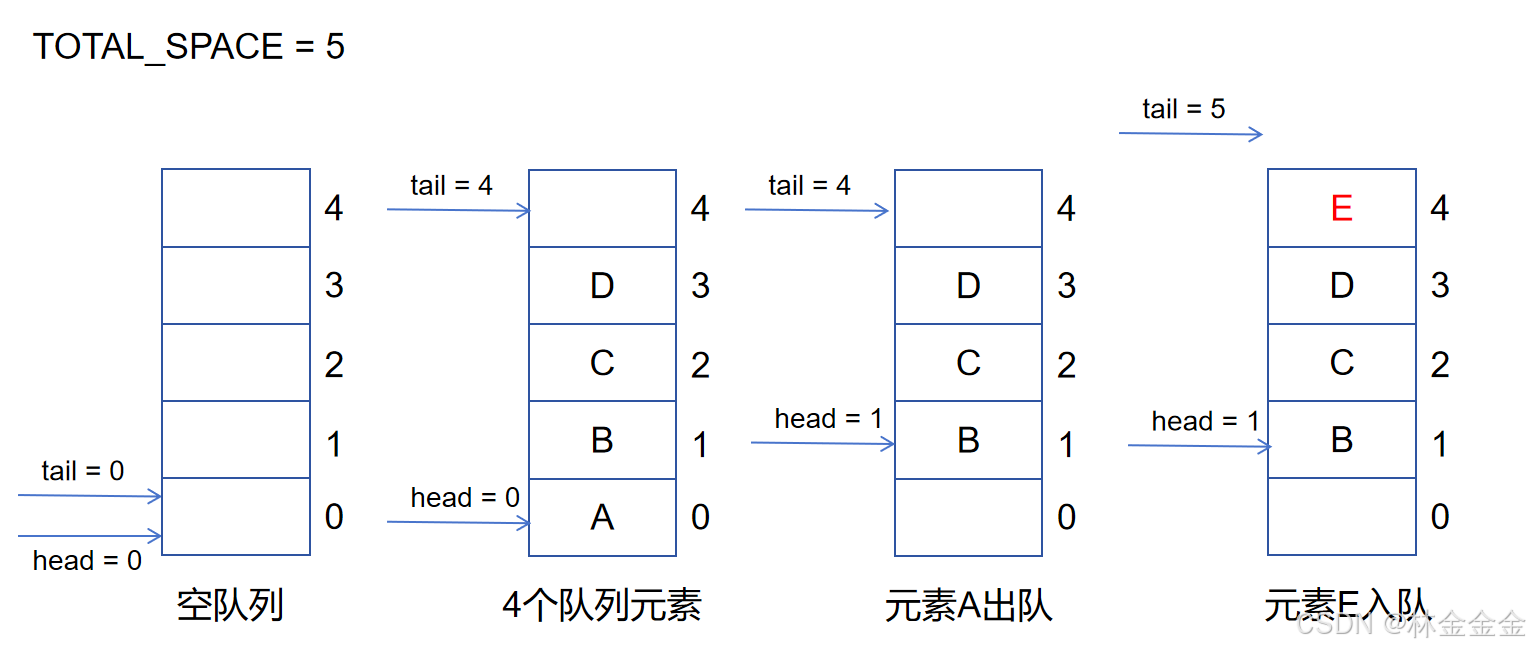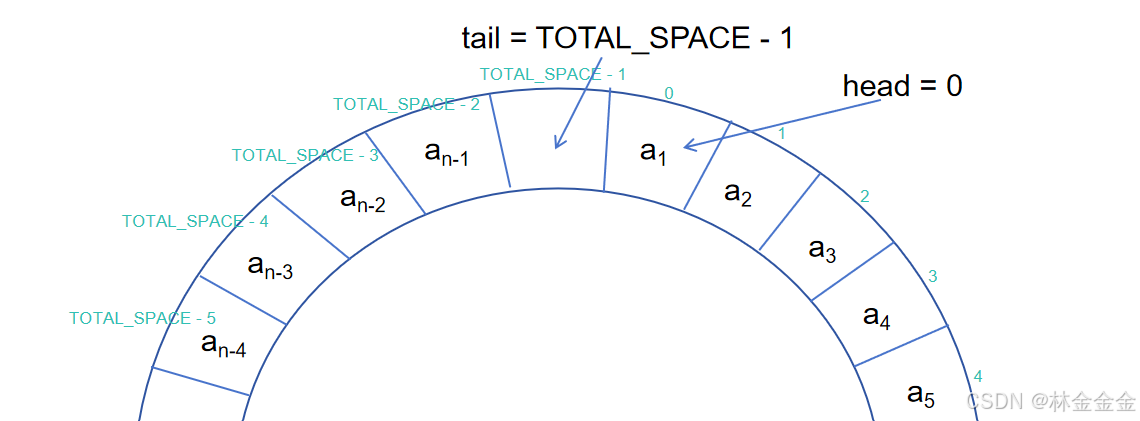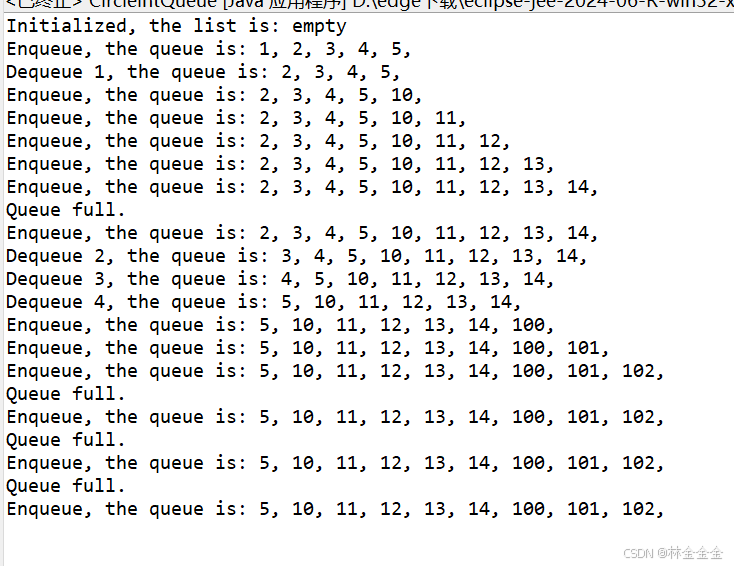目录
一、顺序队列与循环队列
在昨天,我们提到队列实现除了采用链式存储结构,还可以采用顺序存储结构(因为队列是线性表,所以和线性表一样也有顺序、链式两种存储结构)。采用顺序存储结构的队列叫做顺序队列,它是用一组地址连续的存储单元依次存放从队头到队尾的队列元素,其中,需要附设头指针head和尾指针tail,分别指向队头元素和队尾元素。
为方便理解,下面我们用图示进行相关说明(假设队列的总存储空间TOTAL_SPACE = 5):

可以预测,如果我们在元素E之后再插入元素F,那么必然会插入失败,这是因为此时的尾指针tail已经达到队列的最大长度5,所以没办法继续插入元素。但事实上我们可以看到,此时下标为0的存储单元其实是空的,也就是说实际上此时的队列并没有满,这种现象就叫做“假溢出”。
简单来说,“假溢出”的原因就是队列在队头出队、队尾入队,从而造成队头出现空闲单元未被充分利用。为了解决这种“假溢出”现象,避免存储空间浪费,我们将队列的数组看作是头尾相接的循环结构,这种队列头尾相接的循环顺序存储结构就是循环队列,通过这种方式可以重用队头空闲下来的存储单元,如下图:

在循环队列中进行入队、出队操作,头尾指针的指向仍然要+1,不过不同的是,当头尾指针指向TOTAL_SPACE - 1(即头尾指针到达队列的最大长度处)时,此时再+1的结果就变成了头尾指针指向队列下标为0的地方。这种循环意义下的+1操作,可以用以下两种方式进行实现:
-
if( i == TOTAL_SPACE - 1) // i表示head或tail i = 0; else i++; -
i = (i+1) % TOTAL_SPACE; // i表示head或者tail
对于第二种方式,很明显,当头尾指针指向TOTAL_SPACE - 1(即 i = TOTAL_SPACE - 1)时,i + 1就等于TOTAL_SPACE,进行整除运算后得到余数为0,所以i最后等于0;其余时候,i + 1均小于TOTAL_SPACE,所以整除后得到的余数即为i + 1本身,即i最后就等于i + 1。
通过上图,我们还可以发现,当循环队列为空或者已满时,头指针head均等于尾指针tail,这就会导致一个问题:当head = tail时,到底是判空还是判满?
可以通过以下三种方法来解决这个问题(在今天的代码实现中,我们用的是第二种方法):
- 另外设置一个布尔变量,用于区别队空和队满。
- 减少一个存储空间的使用,即把TOTAL_SPACE - 1个队列元素视为已满(也就是说,当下标为TOTAL_SPACE - 2的存储空间被占用,尾指针tail指向TOTAL_SPACE - 1时,视为已满),从而将队空和队满区别开来。因此,队空表示为 head = tail,队满表示为(tail + 1)% TOTAL_SPACE = head。

- 设置一个计数器,用于记录当前队列中的元素个数。计数器初始值为0,新元素入队则计数器+1,元素出队则计数器-1,当计数器 = TOTAL_SPACE时,队满;当计数器 = 0时,队空。
二、代码实现
1.循环队列创建
首先,需要创建类,并定义成员变量、成员方法。由于循环队列是基于顺序表,所以这里大体上和顺序表的创建差不多,只需要再增加头指针head、尾指针tail的声明即可,如下:
public class CircleIntQueue {
/**
* The total space. One space can never be used.
*/
public static final int TOTAL_SPACE = 10;
/**
* The data.
*/
int[] data;
/**
* The index for calculating the head. The actual head is head % TOTAL_SPACE.
*/
int head;
/**
* The index for calculating the tail.
*/
int tail;
/**
*******************
* The constructor
*******************
*/
public CircleIntQueue() {
data = new int[TOTAL_SPACE];
head = 0;
tail = 0;
} // Of the first constructor2.循环队列遍历
/**
*********************
* Overrides the method claimed in Object, the superclass of any class.
*********************
*/
public String toString() {
String resultString = "";
if (head == tail) {
return "empty";
} // Of if
for (int i = head; i < tail; i++) {
resultString += data[i % TOTAL_SPACE] + ", ";
} // Of for i
return resultString;
} // Of toString循环队列的遍历没什么好说的,也是通过重写toString()方法,基本上与之前顺序表的遍历一样。
3.循环队列入队
/**
*********************
* Enqueue.
*
* @param paraValue The value of the new node.
*********************
*/
public void enqueue(int paraValue) {
if ((tail + 1) % TOTAL_SPACE == head) {
System.out.println("Queue full.");
return;
} // Of if
data[tail % TOTAL_SPACE] = paraValue;
tail++;
} // Of enqueue由于顺序表的存储空间有上限,所以在入队之前需要先判断是否队满。根据之前的分析,得到队满判断条件为(tail + 1) % TOTAL_SPACE == head;确定队列未满后,进行入队操作,显然此时tail小于TOTAL_SPACE,所以tail % TOTAL_SPACE = tail,data[ tail % TOTAL_SPACE ]就是指已有队列元素后面第一个空的存储单元,将新元素赋给其即可完成入队,最后不要忘了更新尾指针。
4.循环队列出队
/**
*********************
* Dequeue.
*
* @return The value at the head.
*********************
*/
public int dequeue() {
if (head == tail) {
System.out.println("No element in the queue");
return -1;
} // Of if
int resultValue = data[head % TOTAL_SPACE];
head++;
return resultValue;
} // Of dequeue出队只需判断是否队空,而队空的判断条件也十分简单,即head == tail;判断之后,开始出队,因为head小于TOTAL_SPACE,所以head % TOTAL_SPACE = head,data[ head % TOTAL_SPACE ]即为头指针指向的元素,也就是队头的第一个元素;最后,更新头指针,并返回删除的队列元素。
5.数据测试
方法创建完毕后,进行如下的数据测试:
/**
*********************
* The entrance of the program.
*
* @param args Not used now.
*********************
*/
public static void main(String args[]) {
CircleIntQueue tempQueue = new CircleIntQueue();
System.out.println("Initialized, the list is: " + tempQueue.toString());
for (int i = 0; i < 5; i++) {
tempQueue.enqueue(i + 1);
} // Of for i
System.out.println("Enqueue, the queue is: " + tempQueue.toString());
int tempValue = tempQueue.dequeue();
System.out.println("Dequeue " + tempValue + ", the queue is: " + tempQueue.toString());
for (int i = 0; i < 6; i++) {
tempQueue.enqueue(i + 10);
System.out.println("Enqueue, the queue is: " + tempQueue.toString());
} // Of for i
for (int i = 0; i < 3; i++) {
tempValue = tempQueue.dequeue();
System.out.println("Dequeue " + tempValue + ", the queue is: " + tempQueue.toString());
} // Of for i
for (int i = 0; i < 6; i++) {
tempQueue.enqueue(i + 100);
System.out.println("Enqueue, the queue is: " + tempQueue.toString());
} // Of for i
} // Of main6.完整的程序代码
package datastructure;
/**
* Circle int queue.
*
*@auther Xin Lin 3101540094@qq.com.
*/
public class CircleIntQueue {
/**
* The total space. One space can never be used.
*/
public static final int TOTAL_SPACE = 10;
/**
* The data.
*/
int[] data;
/**
* The index for calculating the head. The actual head is head % TOTAL_SPACE.
*/
int head;
/**
* The index for calculating the tail.
*/
int tail;
/**
*******************
* The constructor
*******************
*/
public CircleIntQueue() {
data = new int[TOTAL_SPACE];
head = 0;
tail = 0;
} // Of the first constructor
/**
*********************
* Enqueue.
*
* @param paraValue The value of the new node.
*********************
*/
public void enqueue(int paraValue) {
if ((tail + 1) % TOTAL_SPACE == head) {
System.out.println("Queue full.");
return;
} // Of if
data[tail % TOTAL_SPACE] = paraValue;
tail++;
} // Of enqueue
/**
*********************
* Dequeue.
*
* @return The value at the head.
*********************
*/
public int dequeue() {
if (head == tail) {
System.out.println("No element in the queue");
return -1;
} // Of if
int resultValue = data[head % TOTAL_SPACE];
head++;
return resultValue;
} // Of dequeue
/**
*********************
* Overrides the method claimed in Object, the superclass of any class.
*********************
*/
public String toString() {
String resultString = "";
if (head == tail) {
return "empty";
} // Of if
for (int i = head; i < tail; i++) {
resultString += data[i % TOTAL_SPACE] + ", ";
} // Of for i
return resultString;
} // Of toString
/**
*********************
* The entrance of the program.
*
* @param args Not used now.
*********************
*/
public static void main(String args[]) {
CircleIntQueue tempQueue = new CircleIntQueue();
System.out.println("Initialized, the list is: " + tempQueue.toString());
for (int i = 0; i < 5; i++) {
tempQueue.enqueue(i + 1);
} // Of for i
System.out.println("Enqueue, the queue is: " + tempQueue.toString());
int tempValue = tempQueue.dequeue();
System.out.println("Dequeue " + tempValue + ", the queue is: " + tempQueue.toString());
for (int i = 0; i < 6; i++) {
tempQueue.enqueue(i + 10);
System.out.println("Enqueue, the queue is: " + tempQueue.toString());
} // Of for i
for (int i = 0; i < 3; i++) {
tempValue = tempQueue.dequeue();
System.out.println("Dequeue " + tempValue + ", the queue is: " + tempQueue.toString());
} // Of for i
for (int i = 0; i < 6; i++) {
tempQueue.enqueue(i + 100);
System.out.println("Enqueue, the queue is: " + tempQueue.toString());
} // Of for i
} // Of main
} // Of class CircleIntQueue
运行结果

补充
将以上程序的int改为char,并作相应调整,即可得到如下的字符队列:
package datastructure.queue;
/**
* Circle queue.
*
*@auther Xin Lin 3101540094@qq.com.
*/
public class CircleCharQueue {
/**
* The total space. One space can never be used.
*/
public static final int TOTAL_SPACE = 10;
/**
* The data.
*/
char[] data;
/**
* The index for calculating the head. The actual head is head % TOTAL_SPACE.
*/
int head;
/**
* The index for calculating the tail.
*/
int tail;
/**
*******************
* The constructor
*******************
*/
public CircleCharQueue() {
data = new char[TOTAL_SPACE];
head = 0;
tail = 0;
} // Of the first constructor
/**
*********************
* Enqueue.
*
* @param paraValue The value of the new node.
*********************
*/
public void enqueue(char paraValue) {
if ((tail + 1) % TOTAL_SPACE == head) {
System.out.println("Queue full.");
return;
} // Of if
data[tail % TOTAL_SPACE] = paraValue;
tail++;
} // Of enqueue
/**
*********************
* Dequeue.
*
* @return The value at the head.
*********************
*/
public char dequeue() {
if (head == tail) {
System.out.println("No element in the queue");
return '\0';
} // Of if
char resultValue = data[head % TOTAL_SPACE];
head++;
return resultValue;
} // Of dequeue
/**
*********************
* Overrides the method claimed in Object, the superclass of any class.
*********************
*/
public String toString() {
String resultString = "";
if (head == tail) {
return "empty";
} // Of if
for (int i = head; i < tail; i++) {
resultString += data[i % TOTAL_SPACE] + ", ";
} // Of for i
return resultString;
} // Of toString
/**
*********************
* The entrance of the program.
*
* @param args Not used now.
*********************
*/
public static void main(String args[]) {
CircleCharQueue tempQueue = new CircleCharQueue();
System.out.println("Initialized, the list is: " + tempQueue.toString());
for (char i = '0'; i < '5'; i++) {
tempQueue.enqueue(i);
} // Of for i
System.out.println("Enqueue, the queue is: " + tempQueue.toString());
char tempValue = tempQueue.dequeue();
System.out.println("Dequeue " + tempValue + ", the queue is: " + tempQueue.toString());
for (char i = 'a'; i < 'f'; i++) {
tempQueue.enqueue(i);
System.out.println("Enqueue, the queue is: " + tempQueue.toString());
} // Of for i
for (int i = 0; i < 3; i++) {
tempValue = tempQueue.dequeue();
System.out.println("Dequeue " + tempValue + ", the queue is: " + tempQueue.toString());
} // Of for i
for (char i = 'A'; i < 'F'; i++) {
tempQueue.enqueue(i);
System.out.println("Enqueue, the queue is: " + tempQueue.toString());
} // Of for i
} // Of main
}// Of class CircleCharQueue
总结
循环队列是一种特殊类型的队列,它在传统顺序队列的基础上进行优化,通过“环形结构”充分利用存储空间,避免了空间浪费;虽然相比于链队列,循环队列似乎没有那么方便,不过在固定大小的缓冲区和任务调度等需要高效处理的数据流场景,循环队列还是非常适用的。昨天,我们学习了链队列,今天学习了循环队列,二者都是对于队列实现的模拟,这启示我们对于同一种逻辑结构,有时是可以采用不同的物理存储结构来实现的。





















 458
458

 被折叠的 条评论
为什么被折叠?
被折叠的 条评论
为什么被折叠?








